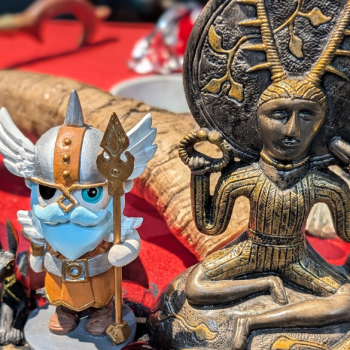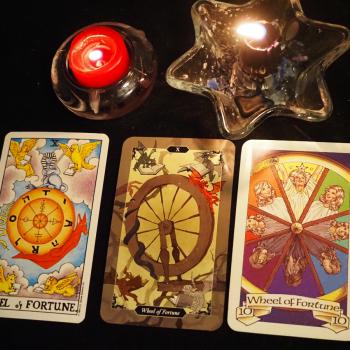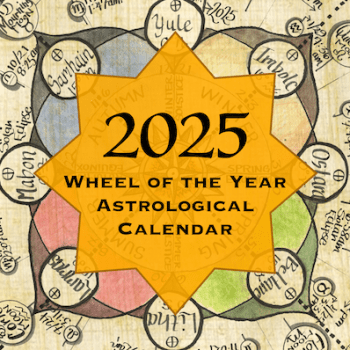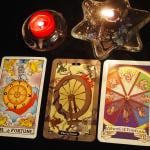A Pagan Almanac for July 24-26, 2012
Lunar Cycle: Sixth to eighth days of the waxing Moon
Athens: Hekatombaion 6, sacred to Artemis
Hekatombaion 7, the Hekatombaia for Apollo (The seventh day is the first quarter, which is always sacred to Apollo)
Hekatombaion 8, sacred to Poseidon and Theseus
Martyred on:
July 24, 1628, Johannes Junius, Burgomaster of Bamberg
July 25, 1591, Dame Euphemia Maclean of North Berwick (the historical records show that she actually may have been a Witch!)
July 26, 1566, Agnes Waterhouse
They died in our name. Let us remember theirs.
William Blake wrote:
I asked a thief to steal me a peach:
He turned up his eyes.
I ask’d a lithe lady to lie her down:
Holy & meek she cries.
As soon as I went an angel came:
He wink’d at the thief
And smil’d at the dame,
And without one word spoke
Had a peach from the tree,
And ‘twixt earnest & joke
Enjoy’d the Lady.
[When life makes me lose a day or two on this project, condensing the days thusly seems efficient.]
_____________________________________________________________________
In September 1975 I was able to visit the Ripley’s corporate headquarters in Toronto for three days, to look over their books and manuscripts. There I met Derek Copperthwaite, then Ripley’s Vice President for Research and Development, who had arranged the purchase of the museum in 1971 from Gardner’s heirs, Monique and Campbell Wilson, and who explained the circumstances of that purchase to me. Derek, a good-humored, well-educated, and cosmopolitan man, understood the history of the Craft and of modern religious studies, quite well; and it was his intuitive grasp of the importance of the various manuscripts in the collection that ensured their safety and their availability for scholarly study.
After Gardner had purchased the museum, located in a building called the “Witches’ Mill” in Castleton on the Isle of Man, from Cecil Williamson in 1951, he had used it to display his accumulated curiosities. At some point, probably after Mrs. Gardner had died in the 1950s, the Wilsons came to live with Gardner, essentially to take care of the old boy and help mind the shop; and when Gardner died childless in 1964, they inherited the property. However, they could not keep up with the work of the museum, and after a few years offered to sell it to Ripley’s.
When Derek and Charles Bristol, Ripley’s Treasurer, arrived on the island to discuss the possibility of a transaction, they found that the Wilsons were desperate. They couldn’t keep the ancient building in repair enough to protect the museum’s contents from the winter rains, which come storming in from the Irish Sea almost continually from November to May. If Ripley’s hadn’t bought the museum, probably much of its contents, especially the books and manuscripts, would simply have perished. Ripley’s had ensured that the raw materials of Craft history had been preserved and taken care of. (They were later sold to Richard and Tamarra James of the Wiccan Church of Canada.)
Once the sale had been agreed upon, the museum’s contents had to be packed up for shipment across the Atlantic. This, Derek said, was an enormous task in itself, since items were crammed into every conceivable nook and cranny in the building. The crew had to dismantle every item of furniture, remove the wall panels, and strip the building down to its studs and rafters, in order to find everything. Hence, Derek assured me, he was quite certain that nothing could have been overlooked.
I asked if any Books of Shadows had been found among the manuscripts, since several people had published statements about Books of Shadows (including one supposedly in Crowley’s handwriting) that Gardner had had on display. He assured me there were no such books, and described some of the abusive crank mail he had received insisting that Ripley’s had no right to own such books and demanding that he turn any such books over to the writer. “These people always describe themselves as the High Priest of Muckety-Muck, or some such nonsense. I can’t imagine why they think I could simply give corporate property away. The only reason we invited you to come was that Charlie Thielen said you seemed sensible and serious.”
“Then I owe him thanks for that. Perhaps,” I suggested, “the working copies of the Book were removed from the collection before the Wilsons called you in.”
“Perhaps so,” he said, “but not likely. The Wilsons had no idea what was valuable in the collection, and what was junk, and were very reluctant to let anything go; so I can’t imagine their willingly turning loose such obviously valuable items. Anyway, the one thing we found that might be a Book of Shadows is this. We found it stuffed way in the back of a cabinet. I haven’t been able to decide whether it’s a Book of Shadows or not; it’s rather odd. I’d like to know what you make of it.”
With these words he handed me the manuscript book titled “Ye Bok of ye Art Magical,” which has turned out to be the key to the puzzle. The book had not begun life as a Book of Shadows, but had become one—in fact, the very first one—by the time it was filled up and retired. Derek assured me that he had personally selected the items sent out for display at Ripley’s various local museums. They were all physical artifacts or things of no conceivable commercial or scholarly value, such as the many pamphlets on occult and fringe religious movements that Gardner had collected. I was therefore able to examine everything that Gardner’s museum had contained, as far as Derek knew, that was relevant to his “reform” of the Craft. There were a few things that supplied me with useful facts.
First, Gardner’s personal library included much of what had been published on witchcraft and the occult between about 1890 and 1950, including precisely the books—Murray, Crowley, Leland, etc.—that I already knew he had used as sources for his rituals. There were also about a hundred older “rare” books and manuscripts on occult topics ranging from the 16th to 19th centuries, but none of them seemed interesting, valuable, or relevant to the Craft.
Second, Gardner had saved correspondence from the 1940s or earlier, but there were no mentions of the Craft except in a single file of correspondence, dating from 1957 to 1962, which seemed to be complete. (I now know that Doreen Valiente took all the correspondence from before 1957 with her when the coven was divided in February 1957.) Most of these letters were from such well-known Gardnerians as Patricia Crowther, Lois Hemmings, Jack Bracelin, the Wilsons, and Charles Clark. There was also a very odd letter from “Ameth” to “Dafo”; since in 1975 I still thought “Dafo” had been Doreen Valiente’s coven name, I could not imagine who “Ameth” was.
Third, a typescript, titled “New Light on Witchcraft,” was the carbon copy of the unedited manuscript of Witchcraft Today, in the form in which it went to the publisher. Glancing through it, I discovered it was in excellent shape. But obviously Gardner—who, as I said, was marginally dyslexic—had not produced this MS. by himself; he had had some very competent help, and I guessed at the time that it might have come from his wife. Doreen Valiente suggested to me that it may have been Dolores North or simply some hired help. I think it highly significant that the editor whom he thanks in the Preface, Ross Nichols, was a member of the Ancient Order of Druids, the same order that used Old Dorothy’s sword for its Stonehenge ritual; in fact, Nichols was elected Chosen Chief of the Order about the time Gardner died. Several manuscript books of the Order’s rituals were also among the Toronto holdings.
Fourth, there were 18 notebooks filled with Gardner’s notes on his reading, mainly in preparation for writing The Meaning of Witchcraft. These also contained a few passages that were first drafts of materials that later went into the Book of Shadows.
Fifth, in the file of letters about the Craft, I found a document titled “Proposed Rules for the Craft.” It could be dated to June 1957 because there was also a letter of that date from Jack Bracelin, Gardner’s supposed biographer, which referred to them as “Ned’s proposed rules for the Craft.” [Ned was the High Priest who hived off with Doreen in February 1957 to begin the second coven.] These rules greatly overlapped the concerns of the “Craft Laws” document, and were, I finally realized, many months later, the first draft of the “Craft Laws.” Given that hypothesis, I was able to identify an earlier draft of every passage in the “Craft Laws” somewhere else in Gardner’s published or unpublished writings. Where later and earlier versions of the same passages had been published, often the later passages had been archaicized by incorporation of obscure words gleaned from the Oxford English Dictionar. Doreen Valiente later told me that she had precisely such a list, in Gardner’s writing, which he had sent her along with a replacement copy of the “Craft Laws,” since she and her coven had burned the first copy that he had sent in their cauldron as an act of literary criticism.
When I returned home from Toronto, I had already found all the facts needed to demonstrate that nothing in the “Craft Laws,” or in the entire Book of Shadows, makes sense as part of a tradition received from a pre-1939 coven, although it took me many months to think it all through. Also, the very ordinary bits of evidence (addresses, letters, diaries, even laundry lists) that we would expect to find for the existence of a pre-1939 coven were nowhere to be found; and in scholarly history, this sort of situation almost always means that somebody is making up a tall tale.
In nuclear physics, even if a particle is very difficult to detect, its existence must have some detectable effects. If those effects cannot be detected after statistically sufficient efforts to detect them, we can be sure the particle does not exist. Similarly, the existence of a pre-1939 coven would have left detectable traces somewhere in the Book of Shadows. Since no effects at all can be found, we have no reason to think that a coven which had its own Book of Shadows existed—and so the organizational link with the past is broken. Philip Heselton has now succeeded in describing the group that did exist before Gardner; it was not Gardnerian, not Wiccan, and certainly not based on a book thought to be authoritative.
In 1975 and 1976 I still thought Gardner’s claims were probably true: I wanted the Craft Laws to be based on traditional documents; I wanted there to have been some tradition behind Gardner’s coven; I wanted there to have been an ancient religion of a Mother Goddess. It took me months to think through the implications of the evidence I had collected, because I was forced step by step to conclude that what I wanted to be true simply was not historically true. This methodological fact is an important part of my argument. Certainly if I had been an Evangelical going to Toronto to do battle with Satan and all his works, I might easily have overlooked important evidence. Instead, I was looking for facts that would support the Gardnerian claims, and I wanted to find them. If there had been any in Toronto, I would not have overlooked them. The reason I could not find any, therefore, is that they almost certainly do not exist.
However, none of that means that the Craft is not a genuine religion. It certainly is. What it means is that we must reassess Gardner as a true religious genius. He did create a new religion, and very few people in history have managed to do that.
If you would like more details about this research, you might try buying my Inventing Witchcraft: A Case Study in the Creation of a New Religion, published by Tom Clarke’s Thoth Publications in Leicestershire, UK, and available on Amazon.















